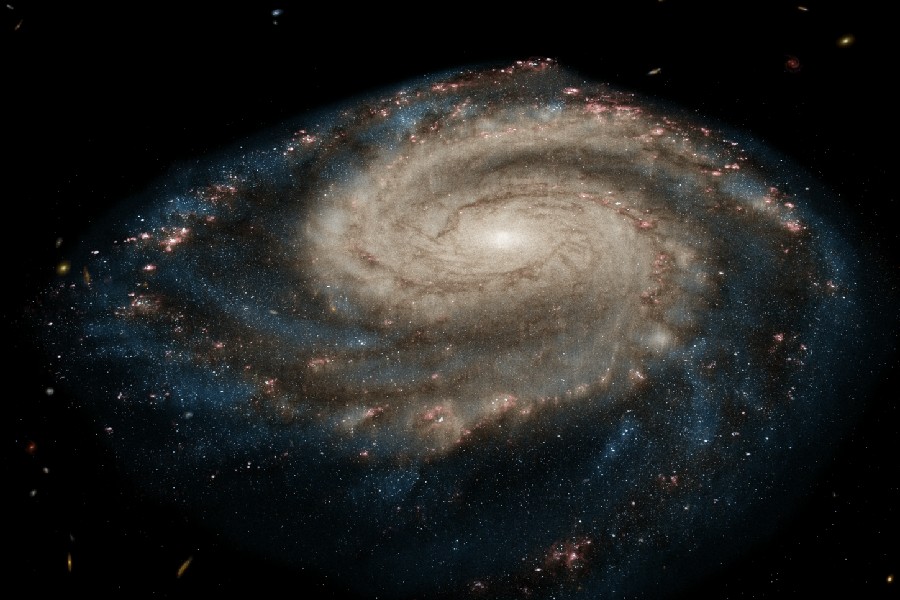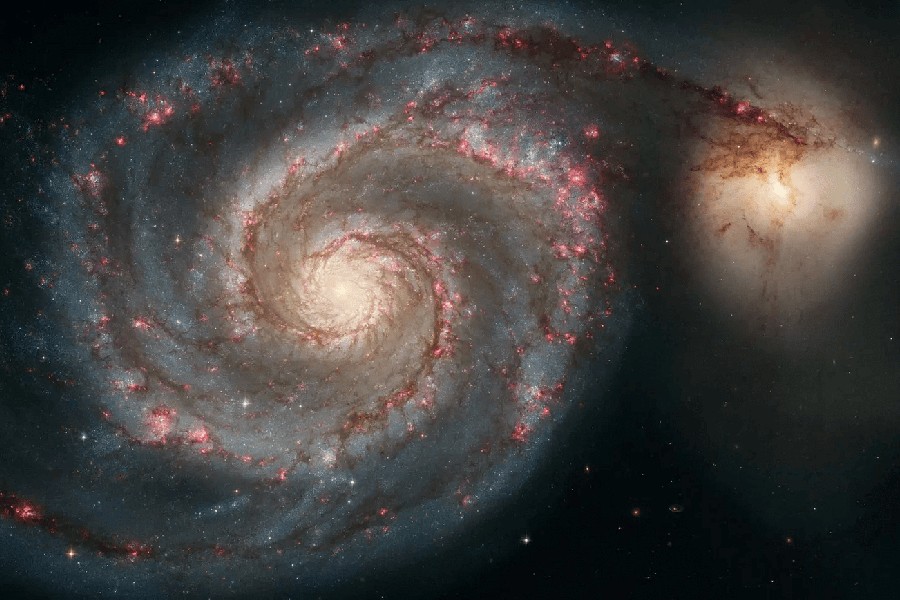Among the many galaxies observable from Earth, the Whirlpool Galaxy stands out as one of the most photogenic and intriguing. Its iconic spiral structure winding outward from a brilliant core has made it a favorite target for astrophotographers.
So, this article will explore the galaxy by covering its size, structure, contents, and other basic facts and figures. It will also discuss the companion galaxy and the subtle and dramatic effects their gravitational dance has.
Studying this interacting pair will also give you insights into galactic life cycles. Let’s get started!

Whirlpool Galaxy
The Whirlpool Galaxy, or Messier 51, is like the celestial Picasso of galaxies, residing about 23 million light-years away in Canes Venatici. Not only is it a lone star, but it’s in a gravitational dance with another galaxy, NGC 5195.
This dynamic duo doesn’t just dazzle our cosmic senses; their gravitational interaction is sculpting their shapes. If you ever gaze at the night sky, the galaxy is that captivating swirl. It reminds us of the vast wonders dancing in the universe.
How to Spot the Whirlpool Galaxy
Best time for observation
Looking to observe the M51 Whirlpool Galaxy? Spring is your cosmic friend. This beauty graces our night sky from April to October, with May and June offering prime viewing. During these months, it’s like the galaxy is putting on a celestial show, so mark your stargazing calendar.
Telescope requirements
The galaxy isn’t a diva; even a moderate telescope can unveil its spiral elegance. A 6-inch telescope should do the trick.
Remember, it’s not just about the size. A clear, dark sky away from city lights is the real VIP for a stellar Whirlpool experience.
Whirlpool Galaxy Characteristics
Distance and location
The galaxy is our neighbor, about 23 million light-years away, chilling in the Canes Venatici constellation. It’s like the cool kid on the galactic block, not too far or close, just right for our telescopic eyes.
Size and structure
Size matters in space, and the galaxy rocks it at about 60,000 light-years in diameter. Imagine a cosmic pinwheel twirling in the vastness. Its spiral arms aren’t just for show. They’re the dance floor of stellar activity, where stars are born, and galaxies throw their best swirls.
Notable features
The Whirlpool Galaxy isn’t shy about its unique traits. Check out its companion, NGC 5195, tagging along in this galactic adventure. Like cosmic contour lines, you’ll notice dark dust lanes adding drama to the scene. It’s a celestial masterpiece with features that stand out in our starry neighborhood.
The Science Behind the Whirlpool
Star formation processes
The Whirlpool offers a perfect lab for unraveling how stars form. Within dense clouds inside the swirling arms, hydrogen gases collapse under gravity. This collapse sparks fusion, giving birth to new stars.
We can also examine stellar nurseries as clusters of infant stars emerge, their light carving cavities into the surrounding gas. Studying this galaxy teaches us about the processes of turning primordial matter into glowing spheres that generate elements and enable orbiting planets.
Galactic evolution insights
More than a beautiful sight, the Whirlpool preserves pivotal waypoints in its long history for astronomers to reconstruct. We continue to add chapters to our cosmic photo album by examining how structure and star populations vary with radius.
Also, the inner bulge and grand arms reveal gradual growth over billions of years – from colliding neighbors to disrupted satellites merging into the rotating disk. The Whirlpool’s continuous trip through space and time is characterized by waves in chemistry and density, much like archeological layers.

Galactic Companions: The Whirlpool’s Cosmic Dance
Satellite galaxies
The galaxy is not alone; satellite galaxies accompany it. Consider them cosmic sidekicks who follow the Whirlpool on its celestial journey. They add diversity to the cosmic neighborhood, creating a visual feast for those peering through telescopes.
Interactions and gravitational dynamics among galaxies
It’s not just a silent cosmic display; there’s a gravitational dance happening among galaxies. Imagine them swaying and twirling, influenced by unseen forces.
The Whirlpool interacts with its neighbors, altering their courses and producing a vibrant galactic symphony with its gravitational attraction. It’s like a celestial ballet where gravity takes the lead, orchestrating the mesmerizing movements of the cosmic dancers.
Stellar Nurseries: The Whirlpool’s Active Star Formation
Nebulae and star clusters
Picture the Whirlpool Galaxy as a bustling maternity ward in space. Nebulae and star clusters within their spiral arms are like cosmic cribs, where baby stars are born. It’s a stellar nursery filled with gas and dust, nurturing the next generation of twinkling cosmic lights in the Whirlpool’s spiral embrace.
The Whirlpool’s star-forming regions
Scientists use their cosmic detective gear to explore the Whirlpool’s star-forming hotspots. Using telescopes tuned to detect specific wavelengths, they uncover the secrets of stellar birth.
It’s like peeking into the galaxy’s photo album, capturing moments of cosmic creation. It also helps understand the stellar life cycle within the Whirlpool’s swirling arms.
Frequently Asked Questions
Why is it called the Whirlpool Galaxy?
The Whirlpool Galaxy gets its swirling, whirlpool-like appearance from its winding spiral arms emanating from the galactic center. This provides a pinwheel shape that rotates every 300 million years. The arms trace density waves of stars orbiting the core, following the spiral pattern like water swirling around a drain.
What makes the Whirlpool Galaxy special?
A key feature that makes M51 special is its ongoing gravitational interaction with its smaller companion galaxy, NGC 5195. This cosmic dance has triggered enhanced star formation. It has also created structures like curling tidal arms extending beyond the main galactic disk as gravity distorts both galaxies.
Could the Whirlpool Galaxy harbor life?
While some speculate its billions of stars may host exoplanets that support life, there is no direct evidence yet of life in the turbulent Whirlpool system. However, studying the interaction offers insights into galactic evolution patterns that may impact habitability over billions of years.
Conclusion
The Whirlpool Galaxy continues to enthrall astronomers and casual observers with its grand spiral structure and active galactic interactions. As we have explored, its gravitational dance with companion galaxy NGC 5195 has unlocked a unique chance to study the effects of a galactic encounter still in progress.
This encounter spurs starburst events in the galaxies and likely impacts any planetary systems therein. By analyzing the abundant star clusters born from these compressed gas clouds, the secrets encoded in the galaxy can teach us much.
Hence, these secrets reveal insights into star formation, galactic evolution, and even how the wider cosmos recycles elements through generations of stars. This glimpse into this galaxy furthers our understanding of our place in the intricate cosmic web.
